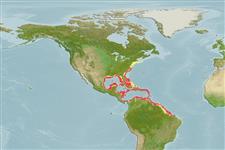Common names from other countries
>
Eupercaria/misc (Various families in series Eupercaria) >
Lutjanidae (Snappers) > Lutjaninae
Etymology: Lutjanus: Malay, ikan lutjan, name of a fish.
More on author: Cuvier.
Environment: milieu / climate zone / depth range / distribution range
Ecología
marino asociado a arrecife; rango de profundidad 20 - 200 m (Ref. 9626), usually 80 - 150 m (Ref. 55). Subtropical; 43°N - 3°S, 100°W - 38°W (Ref. 55227)
Western Atlantic: as far north as North Carolina, USA and Bermuda south to Trinidad and northern Brazil; including the Gulf of Mexico (Ref. 9626). Very common in the Caribbean, particularly the Antilles.
Length at first maturity / Tamaño / Peso / Age
Maturity: Lm 28.7, range 21 - 25 cm
Max length : 75.0 cm TL macho / no sexado; (Ref. 9710); common length : 50.0 cm TL macho / no sexado; (Ref. 55); peso máximo publicado: 14.0 kg (Ref. 9710)
Espinas dorsales (total) : 10; Radios blandos dorsales (total) : 14; Espinas anales: 3; Radios blandos anales: 8. Preopercular notch and knob weak. Scale rows on back rising obliquely above lateral line. Mainly scarlet red, silvery on lower sides and belly; fins are yellowish to orange. A prominent black blotch is at the base and in axil of pectoral fins.
Adults inhabit deeper waters over sandy or rocky bottoms and near drop-offs and ledges. Young occur in shallower water, often between about 35 and 50 m. Feed mainly on fishes. Good food fish, it is marketed mostly fresh (Ref. 55).
Life cycle and mating behavior
Maturities | Reproducción | Spawnings | Egg(s) | Fecundities | Larva
Allen, G.R., 1985. FAO Species Catalogue. Vol. 6. Snappers of the world. An annotated and illustrated catalogue of lutjanid species known to date. FAO Fish. Synop. 125(6):208 p. Rome: FAO. (Ref. 55)
IUCN Red List Status (Ref. 130435)
CITES (Ref. 128078)
Not Evaluated
Threat to humans
Reports of ciguatera poisoning (Ref. 55)
Human uses
Pesquerías: comercial
Herramientas
Special reports
Download XML
Fuentes de Internet
Estimates based on models
Preferred temperature (Ref.
115969): 18 - 26.2, mean 22.3 (based on 64 cells).
Phylogenetic diversity index (Ref.
82804): PD
50 = 0.5000 [Uniqueness, from 0.5 = low to 2.0 = high].
Bayesian length-weight: a=0.01479 (0.01312 - 0.01667), b=2.97 (2.95 - 2.99), in cm Total Length, based on LWR estimates for this species (Ref.
93245).
Nivel trófico (Ref.
69278): 3.9 ±0.57 se; based on food items.
Resiliencia (Ref.
120179): Medio, población duplicada en un tiempo mínimo de 1.4-4.4 años (K=0.10-0.70).
Fishing Vulnerability (Ref.
59153): High vulnerability (62 of 100).
